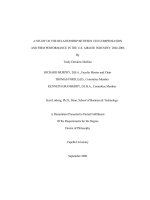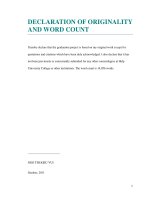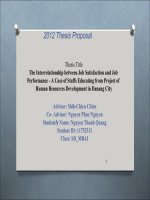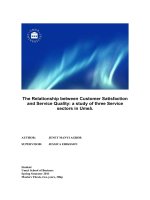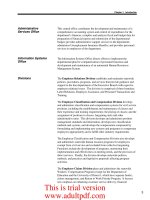The Interrelationship between Job Satisfaction and Job Performance - A Case of Staffs Educating from Project of Human Resources Development in Danang City
Bạn đang xem bản rút gọn của tài liệu. Xem và tải ngay bản đầy đủ của tài liệu tại đây (1.03 MB, 32 trang )
1
Thesis Title
The Interrelationship between Job Satisfaction and Job
Performance - A Case of Staffs Educating from Project of
Human Resources Development in Danang City
Advisor: Shih-Chien Chien
Co- Advisor: Nguyen Phuc Nguyen
Studentᾼs Name: Nguyen Thanh Quang
Student ID: 11752311
Class: SD_MBA1
2012 Thesis Proposal
2
KEY WORDS
O Job Satisfaction
O Job Performance
O Job Characteristics
O Personal Outcomes
O Work Outcomes
O Psychological States
3
Outlines
1. Introduction
2. Literature Review
3. Research Framework and
Methodology
4. Concluding Remarks
4
1. Introduction
1.1 Research Background
O Job satisfaction plays an important role in managing human
resource strategies of organizations. It can be said that the
importance of effective managing human resources strategies
greatly depend on how well employees are being satisfied in
that organization.
O According to Lumley et al. (2011) cited in Spector (1997) that
job satisfaction influences peopleᾼs attitude toward their job
and various aspects of their job.
O Ellickson and Logsdon (2001) quoted from Spector (1997)
indicated that the result of dissatisfied workers show an
increased propensity for counterproductive behaviors,
including withdrawal, burnout, and workplace aggression.
5
O Besides, Saari and Judge (2004) cited the results of some
studies from Hackett and Guion (1985), Hulin, Roznowski, and
Hachiya (1985) and Kohler and Mathieu (1993) shown that
dissatisfied employees are more likely to quit their jobs or be
absent than satisfied employees.
O Furthermore, Morrison (2008) mentioned that the results of job
satisfaction are better performance, reduction in withdrawal
and counter-productive behaviors.
O Therefore job satisfaction involves the affect and emotions of
employees; it influences the well-being of organization with
regard to job productivity, employee turnover, absenteeism and
life satisfaction (Lumley et al., 2011; Sempane, Rieger, &
Roodt , 2002; Spector , 2008).
6
O A satisfied employee will create a pleasant atmosphere in
organisation and attain high level performance through
efficiency. Employees seem to be motivated to do grater effort
when they feel pleasure and highly satisfaction in their job.
The total organization efficiency and performance employees
depend on how well individual employee shows their effective
performance in the organisation. Thus, employee effort is one
of an important factor that necessity for determining an
individual performance (Pushpakumari, M. D. 2008).
O To date, research on job satisfaction and job performance had
particular interested due to the inconsistent finding the
literature with regard to the factors affecting job satisfaction
and job performance. Especially, regarding to the relationship
between job performance and job satisfaction (cited in Kim,
H., Knight, D.K., & Crutsinger, C. (2009. p550).
7
O There are many theories are measured by job satisfaction. Such
as:
O Affect theory
O Dispositional theory
O Opponent process theory
O Equity theory
O Discrepancy theory
O Two-factor theory (motivator-hygiene theory)
O Job characteristics model
O For job performance, a job performance model of motivation
is employed.
8
O The study tries to identify the factors, which are effect on job
satisfaction of employees that educated from the Project of
Human Resources Development in Danang city. It is also
discover the interrelationship between job satisfaction and job
performance.
O The job characteristics model developed by Hackman and
Oldman (1975) is now considered the most popular model
studying on job characteristics which could assess the extent of
overall job characteristics that affects employeeᾼ attitudes like
job satisfaction and quality of work performance.
O This study tries to use job characteristics model as a ascendant
variables to influence job satisfaction for the case of the Project
of Human Resources Development in Danang city.
9
1.Introduction
1.2 The Project Human Resources Development of Danang
city
1.2.1 History of Project
Besides the attracting talent, the city has invested a huge fund
scholarship for excellent students and staffs to higher educate
in the country and abroad. In 2004, project sponsoring students
to study abroad by the city's budget (known as Project 47) was
implemented. Then, Project for training 100 masters, doctors at
foreign universities (known as Project 393) was founded in
2006. Finally, Projects 47 and 393 has been unified in 2010 as
Project of human resources development.
10
1.Introduction
1.2.2 Objectives of Project
O The main objectives of Project Human Resources Development are to
create good managers and excellent experts in many fields for serving
economic-social development of the city in the time of industrialization
and modernization and especially in the period of
integrated international.
O The number of gifted students sponsor for each year: Undergraduates
study abroad are 20 students and study in Vietnam are 40 students;
Postgraduates study abroad are 10 students. The Project concentrate on
group training programs as Economics, Engineering -
technology, law, administration, construction - urban management,
health, pedagogy. The expensive fees scholarship for every year: 3 - 3.5
millions USD.
1.2.3 Results of Project
O The total number students joining Project (updated until 6/2012) are
428 (Undergraduates: 332; Postgraduates: 80 Masters; 18: Doctors).
After many years education, 159 persons had graduated and are
working at Departments belong to Danang government.
11
1.Introduction
1.3 Research Motivation
O I wonder why I am interested in this problem and what are
benefits bring to me. The first thing what I concern is a raising
concern about brain drain from public sectors to enterprises,
especially moving to foreign-invested enterprises or going to
abroad for working. It can be said that effective use and
retaining talent is one of the priority policies of Danang city. it
will require a study on job satisfaction and job performance of
these staffs.
O Secondly, there are a stronger requirement of customer
orientation for public government services, so the government
need to produce a higher service performance.
O From above study, the research can offer a clear path to set up
an effective policies and maintain a good level of service
quality for people in the future.
12
1.Introduction
1.4 Research Purposes
O 1. Is there a relationship between job characteristics (namely,
Skill Variety, Task Identity, Task significance, Autonomy,
Feedback) and job satisfaction?
O 2. The control variables (namely Gender, Educational level,
Country training, Occupational class, Experience, Tenure, Age,
Marital status, Salary) play a moderator to affect job
satisfaction and job performance.
O 3. Is there a relationship between job satisfaction and job
Performance?
13
2.Literature Reviews
O 2.1 Introduction
O 2.2 Job Satisfaction
O 2.3 Job Performance
O 2.4 Job Characteristics Model
O According to Johari, Mit, and Yahya (2009) cited Morgeson et al.
(2006) stated that the earliest version of job characteristics dimensions
was developed by Turner and Lawence which are two dimensions
dealing with others and friendship opportunities. However, it was
omitted because there was not related to the job characteristics.
O The job characteristics model developed by Hackman and Oldman
(1975) is now considered the most popular model studying on job
characteristics.
O According to Rungtusanatham and Anderson (1996, p.358) quoted
from Hackman and Oldham (1980) defined the Job Characteristics
Model is ᾿ a formal theory of the impact of job enrichment on job
incumbentsΆ affective states and performance῀ .
14
2.Literature Reviews
15
2.Literature Reviews
O The Job Characteristics Model considers that the motivation to work is a
function of three critical psychological states which are Experienced
Meaningfulness of the work, Experienced Responsibility for outcomes
of the work and Knowledge of the Actual Results of the Work Activities
(cited in Thakor and Joshi, 2005; Rungtusanatham and Anderson, 1996).
O Furthermore, the three critical psychological states above are affecting
to several personal and work outcomes. It is determined by five job
characteristics (namely, Skill Variety, Task Identity, Task significance,
Autonomy, Feedback) by Thakor and Joshi (2005) that cited in
Hackman and Oldham (1980).
O Skill Variety, Task Identity, Task significance are define three variables
affecting to Experienced Meaningfulness of the work; while autonomy
is directly influencing to Experienced Responsibility for outcomes of the
work and feedback as directly affecting Knowledge of the Actual
Results of the Work Activities (cited in Rungtusanatham and Anderson,
1996).
16
2.Literature Reviews
Research Framework
17
2.Literature Reviews
2.5 Job Satisfaction and Job Performance
The study of the relationship between job satisfaction and job
performance is one of the most venerable research traditions in
industrial-organizational psychology. It has been studied for
decades and the earliest studies considered the potential linkage
between employee attitudes and performance was of the
Hawthorne studies in the 1930s and the human relations
movement. Following the human relations movement, Brayfied
and Crockett (1955) published a narrative review of the job
satisfaction ᾶ job performance relationship.
There were several other influential narrative reviews that have
been published since the Brayfied and Crockett review which are
Herzberg et al., 1957; Locke, 1970; Schwab & Cummings, 1970;
Vroom, 1964. These reviews differed greatly in their orientation,
perceptions or optimism when they regarding the relationship
between satisfaction and performance.
18
2.Literature Reviews
2.6 Job Characteristics and Job Satisfaction
O According to Jubdi, Samah, and Saad (2007) found that there is a
relationship between job characteristics and motivation,
satisfaction, effectiveness, their stated that job characteristics
contribute to motivation, satisfaction and effectiveness.
O Moreover, four job characteristics (namely, task significance,
task variety, task identity and feedback as significant positive
predictors of job satisfaction by Hadi and Adil (2010) that cited
in Hunter (2006).
O Besides, Hadi and Adil (2010) found in their study that the model
comprising of job characteristics was statistically significant in
predicting job satisfaction. Their also concluded that skill variety
and task identity were significant and positive predictors of job
satisfaction.
19
2.Literature Reviews
O According to Suman and Srivastava (2009, p.143) cited in Brown
and Peterson (1993) showed that greater amount of feedback,
variety, autonomy and other positive job characteristics are
associated with greater job satisfaction.
O Further studies also indicated that there is a strong positive
relationship between job characteristics and job satisfaction
(Loher et al., 1985; Thomas et al., 2004).
20
3.Research Methods
3.1 Research design
O Using non-probability sampling design for the purpose of the
study, it is considered to be appropriate rather than the data in
our research because of social research is often conducted in
situations where a researcher cannot select the kinds of
probability samples used in large-scale social surveys.
O for said study will be obtained with help of survey instrument.
The appropriate tool to determine and assess attitude data is
pre-determined instrument based Questions. In this study, the
author has identified different variables and studied their
relationship to depend variables of job satisfaction and job
performance. Quantitative approach is an appropriate strategy
to study.
21
Rungtusanatham, M., &
Anderson, J. C. (1996).
Renn, R. W., &
Vandenberg, R. J. (1995).
Suman, S. & Srivastava, A.
K. (2009)
- Variety job
- Opportunity to
complete
- Job infulence on
others
Skill variety is described as
the degree to which a job
requires as variety of
different activities in
carrying out the work,
which involve the use of a
number of different skills
and talents of the employees
Skill varietyExperienced
meaningfulness
Rungtusanatham, M., &
Anderson, J. C. (1996).
Renn, R. W., &
Vandenberg, R. J. (1995).
Suman, S. & Srivastava, A.
K. (2009))
- Opportunitiy to work
on many -
Interesting projects
Task identity is the degree
to which the job requires
completion of a whole and
identifiable piece of work
Task
Identity
Rungtusanatham, M., &
Anderson, J. C. (1996).
Renn, R. W., &
Vandenberg, R. J. (1995).
Suman, S. & Srivastava, A.
K. (2009)
-Influence on
organization
- Relate to the
business mission
- Influence on day-to-
day company success
Task significance is the
degree to which the job has
a substantial impact on the
lives or work of other
people, whether the
immediate organization or
in the external environment
Task
Significant
LR supportVariablesOperation DefinitionFactorConstruct
3.2 Operation Definition for each construct
22
Rungtusanatham, M., &
Anderson, J. C. (1996).
Renn, R. W., &
Vandenberg, R. J. (1995).
Suman, S. & Srivastava, A.
K. (2009)
- Sef-directed
flexbility
-Independently
action
- Use many
technology
It is the degree to which
the job provides substantial
freedom, independence,
and judgment to the
individual in scheduling
the work and in
determining the procedures
to be used in carrying it out
AutonomyExperienced
Responsibilities for
outcomes of the work
Rungtusanatham, M., &
Anderson, J. C. (1996).
Renn, R. W., &
Vandenberg, R. J. (1995).
Suman, S. & Srivastava, A.
K. (2009)
-Feedback from
my co-workers
- Feedback by
itself
Feedback is the degree to
which the employee
receives clear information
about his or her
performance
FeedbackUnderstand the
outcomes of the work
LR supportVariablesOperation DefinitionFactorConstruct
3.2 Operation Definition for each construct
23
Pushpakumari,
M. D. (2008)
- Ellickson, M. C.,
& Logsdon, K.
(2001)
-Work feeling
-Co-operation and Personal
relations
- Team working and
developing others
- Remuneration/pay
- Supervision
- Promotion opportunities
- Job status
- Job level
A pleasurable or positive
emotional state resulting
from the appraisal of
oneᾼs job or job
experience. Job
satisfaction is a result of
employeesᾼ perception of
how well their job
provides those things
which are viewed as
important
Job Satisfaction
- Sonnentag, S., &
Frese, M. (2002)
- Khan*, A. H.,
Nawaz, M. M., Aleem,
M., & and Hamed, W.
(2012)
- Quality of work
-Quantity of work
- Job Knowledge
- Dependability
-Co-operation and Personal
relations
- Responsibility Team
working and developing
others
Accomplishment of
work-related tasks or
skills by an employee or
trainee, it may refer to
specific skills or to
overall performance
Job Performance
LR supportVariablesOperation DefinitionFactorConstruct
3.2 Operation Definition for each construct
24
3.Research Methods
3.3 Methodology
3.3.1 Descriptive Statistics
3.3.2 Reliability and Validity of the questionnaires
3.3.3 The Pearson Product Moment Correlation Coefficient
3.3.4 Analysis of Variance (ANOVA)
3.3.5 Moderating effect (control variables) on Job Satisfaction
and Job Performance
3.3.6 Multiple Regression Equation
25
3.Research Methods
3.4 Sample and procedure plan
Question Design/Theoretical Basis
O We design Demographic characteristics questionnaires that is
related to Control variables.
O We design Job Characteristics Scale questionnaires. For the
form of the scale, many items were constructed. The items of
the scale cover five dimension related to job characteristics
(Skill variety, task identity, task significant, autonomy and
feedback). Each item is to be rate on 7-point scale (1 =
Strongly disagree, 2 = Disagree, 3 = Slightly Disagree, 4 =
Undecided, 5 = Slightly Agree, 6 = Agree, 7 = Strongly
Agree).
